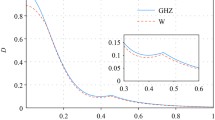Abstract
We discuss two classical situations that lead to probabilities characteristic for systems with spin-1/2. (a) Pitowsky model: It is demonstrated that the definition of spin functions does not imply which circle (a parallel or a great circle) on the sphere should be taken as a probability space in calculation of conditional probabilities. Pitowsky's choice of parallels must be formulated as an assumption about the model. It is shown that the model explicitly avoiding this difficulty is possible and no contradiction with the Bell Theorem is found. The modification is based on a new pathological decomposition of the sphere and belongs to a class of hidden variable theories with undetected signals. (b) Aerts model: We show the importance of the “polarization effect” of the measurements for the sake of obtaining a non-Kolmogorovian probability model. It is also shown that the conditioning by a change of state leads in general to the non-Kolmogorovian probability calculus.
Similar content being viewed by others
References
I. Pitowsky,Phys. Rev. D 27, 2316 (1983).
(a) D. Aerts,J. Math. Phys. 27, 202 (1986). (b) D. Aerts, “The origin of the non classical character of the quantum probability model,” inInformation, Complexity and Control in Quantum Physics, A. Blanquiere, S. Dinier, and G. Lochak, eds. (Springer, New York, 1987). (c) D. Aerts,Helv. Phys. Acta 64, 1 (1991).
S. P. Gudder,J. Math. Phys. 25, 2397 (1984).
I. Pitowsky,Quantum Probability — Quantum Logic, Lecture Notes in Physics321 (Springer, New York, 1989).
E. T. Jaynes,Found. Phys. 3, 477 (1973).
R. Jozsa,Found. Phys. 19, 1327 (1989).
M. Czachor,Phys. Lett. A 129, 291 (1988).
P. Billingsley,Probability and Measure (Wiley, New York, 1979).
P. M. Pearle,Phys. Rev. D 2, 1418 (1970).
B. Mielnik,Commun. Math. Phys. 9, 55 (1968).
Author information
Authors and Affiliations
Additional information
2. For example, let ∀Cw,z ∃x∈Cw,zµc ({y ∈C w,z ∩S +|δ(x,y) ≤π/2})=µ c(C w,z ∩S +)= 1/2µ c(C w,z). Pitowsky spheres with white points distributed onC w,z in this way exist. The proof is exactly analogous to this of Theorem 1 in [1]. Then (**) = 1 -θ/π, if one takesC w,z as the probability space. This example seems very instructive.
3. If the chargeq falls down on some point then it clearly has not fallen down on another one. Having given a result of a measurement we cannot, within the model with polarization, talk in a sensible way about its alternative: We can think either aboutsuccessive measurements (then the Bell inequality is not derivable) or ask “What would have happened if...,” but then we deal with a different problem (in Aerts' terminology [2b] this is anobservation) and obtain again Eq. (8) (there is no complementarity but there is no model of spin either).
Rights and permissions
About this article
Cite this article
Czachor, M. On classical models of Spin. Found Phys Lett 5, 249–264 (1992). https://doi.org/10.1007/BF00692802
Received:
Revised:
Issue Date:
DOI: https://doi.org/10.1007/BF00692802




